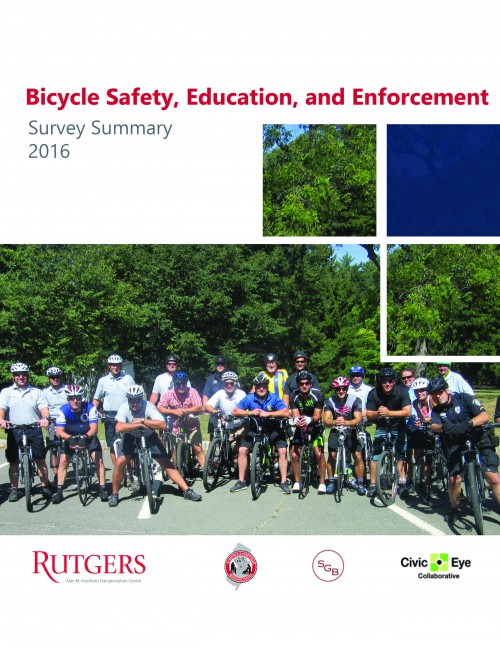Report Summary
The New Jersey Bicycle and Pedestrian Resource Center is engaged in the development of a Bicycle Safety Enforcement and Education (BSEE) initiative to address the gap in comprehensive bicycle enforcement and education within the State. Key components of this initiative are to understand the extent of current activities and perceptions at the local level within New Jersey, review best practices within and beyond New Jersey to inform program development, and to develop BSEE materials and protocols for the use of law enforcement and other identified stakeholders in community law enforcement and education.
A scan of literature and available resources indicates that BSEE is not well addressed in training and continuing education for local law enforcement personnel in the State. In order to better understand current practices, challenges, and barriers to more comprehensive BSEE, an on-line survey of New Jersey law enforcement personnel was undertaken to establish a baseline of attitudes and perceptions of BSEE, confirm or dispel the perception that there is a need for BSEE from the perspective of enforcement personnel, and inform the project team on the current state of BSEE by NJ law enforcement.
Key Findings
As presented in this survey synthesis, the following findings provide an understanding of the current state of BSEE at the local level in New Jersey and point to both the need and desire for more comprehensive BSEE programming among local enforcement personnel:
- Law enforcement carries out limited bike education activities, particularly those designed to reach adults on bicycles. When activities are carried out, they are predominantly youth oriented.
- There is no strategic and structured approach to bicycle safety education for motorists or bicyclists. Officers are also unaware of local bicycle advocacy groups. Officers infrequently seek grants to improve bicycle safety.
- The enforcement community views bicycle safety as an important issue, but did not perceive that importance being shared by local officials.
- Few officers have had training on bicycle laws but most communities have had bicycle crashes in the last five years and many (61%) have had five or more crashes in the past five years.
- When issuing Title 39 citations, it is much easier to identify a violation for a bicyclist than for a motorist. The most frequently cited motorist violation towards bicyclists is “reckless driving” which seems to be a catchall for the lack of more specific violations.
- The most frequently observed driver behavior that endangers bicyclists is passing to closely. New Jersey does not have a safe passing law and very few communities have a local safe passing ordinance.
- There is strong consensus on the need for more resources and training on bicycle laws and how to apply them, on carrying out bicycle enforcement operations as well as community bicycle education programs.
- There is a strong interest in this topic amongst respondents as a majority of officers who participated in the BSEE survey are interested in taking part in future research for the program.
- Bicycle facilities are lacking in most NJ communities and most officers observe both adults and children bicycling on local sidewalks.
- Bicycle patrol is still active in a substantial number of communities with an almost equal number having once had bike patrol but later disbanded it. Bike patrol is most frequently used for routine patrol and community policing activities.
Read full report: Bicycle Safety, Education, and Enforcement Survey Summary (2017)

